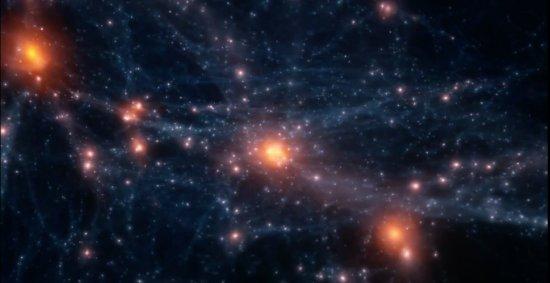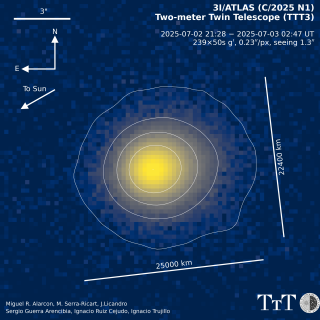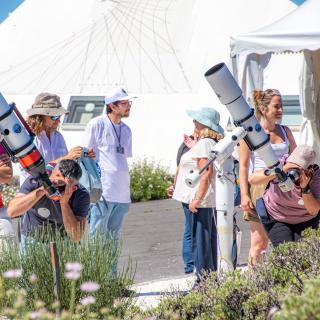The Instituto de Astrofísica de Canarias (IAC) has made a 4 minute video (available on its YouTube, Vimeo and Dailymotion channels) in which the formation and evolution of a cluster of galaxies is simulated. This simulation has been made possible by the computing power of the supercomputer Teide-HPC, the second most powerful machine in Spain, and number 138 in the Top 500 list of the most powerful supercomputers in the world (on November 2013). It belongs to the Institute of Technology and Renewable Energies (ITER) of the Cabildo Insular (Island Parliament) of Tenerife.
The simulation traces the evolution of a single cluster of galaxies, a cosmic structure formed by galaxies grouping together, and maintained linked by their own gravitation. In the animation one can see how, on those huge scales, the normal matter in the universe is held together in interconnected filaments around huge cosmic voids, rather like the structure of a gigantic sponge, as a consequence of the motions of the intergalactic gas, the attraction between the galaxies, and the interaction with the predominant dark matter.
It also shows the distribution of the halos, structures which are the result of the crossing of various filaments, and where the galaxies form and evolve. In the animation these halos are attracted by the cluster towards its own centre, until they form the starting point of a supercluster with a mass greater than a thousand billion times the mass of the Sun.
The brightness in the simulation shows the range of densities of the cosmic gas. The temperature is shown via colour, with red used for the highest temperature, around ten million degrees.
The simulation has been made using a technique termed “zoom in” which allows the computer to concentrate its full calculating power on a small region within the cosmic volume, and by reproducing this periodically can map continuously the distribution of the matter in a large part of the universe.
The computed volume is a cube of dimension 1,600 million light years per side, and the program covers a time interval of 13,000 million years, almost the full lifetime of the universe. The volume takes in some 20,000 clusters of galaxies and estimates the distribution of the mass and the quantity of material present in the halos inside which the galaxies form.
“The space which is simulated” explains Claudio Dalla Vecchia, the IAC researcher who is the author of the simulation, “is based on the standard model of cosmology. Among the variables included in the calculations are the gravitational attraction and the hydrodynamic movement of the cosmic gas, as well as the expansion of the universe. The simulation includes not only the distribution of ordinary matter, but also the abundant and mysterious dark matter”.
The simulation needed two weeks of processing time, with 128 CPU’s working in parallel, which is equivalent to 43,000 hours of computing. However this is only the first step in a much more complete simulation, in which is planned to used 4,000 CPU's for 1,500 hours, in other words six million hours of computing time. “For the coming simulation we will model the complicated systems of feedback which occur during star formation, supernova explosions, and the production of supermassive black holes” adds Dalla Vecchia.
In the full simulation it is predicted that several hundred galaxies will form in each cluster, so that it will be possible to simulate several million galaxies with unprecedented resolution. Some of them will have a similar size to some of the dwarf galaxies which populate our Local Group, which are ten times smaller than the Magellanic Clouds. As well as the mass, the simulation will also account for other properties such as the shape, the size, the speed of star formation, the quantity of heavy elements produced, and the evolution of the stars in each galaxy.
“The simulation” states the IAC astrophysicist Alfonso López Aguerri, who is also participating in the project “represents a physical model of our universe which is very realistic. Thanks to this, the astrophysicists will be able to see, in a few seconds, the complete history of the large scale structure of our universe, resulting from thousands of millions of years of evolution. It is also a very valuable tool for making theoretical predictions which can then be compared to data obtained from astronomical observations”.
Simulation of the formation and evolution of a cluster of galaxies with the supercomputer Teide-HPC: Youtube, Vimeo, Dailymotion
Project: “The influence of cluster environments on the structure and evolution of galaxies”, Alfonso López Aguerri y Claudio Dalla Vecchia.
Simulation: Claudio Dalla Vecchia
Computation: Teide-HPC
Visualization software: Splotch http://www.mpa-garching.mpg.de/~kdolag/Splotch/
Simulation software: Anarchy
Texts: Iván Jiménez
Music: Stellardrone, “A moment of Stillness” (CC BY 3.0)
Production: Unidad de Comunicación y Cultura Científica (UC3) del IAC



